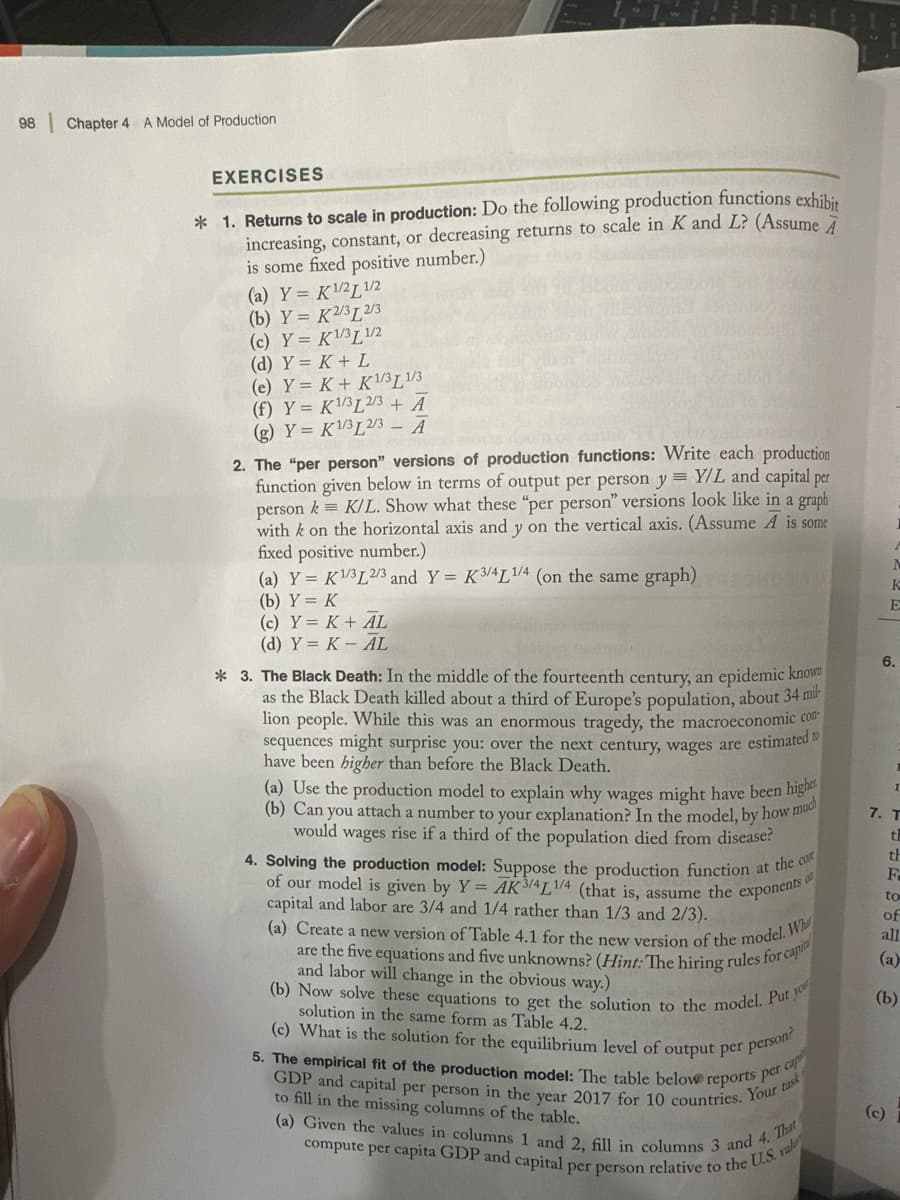* 1. Returns to scale in production: Do the following production functions exhibit increasing, constant, or decreasing returns to scale in K and L? (Assume A is some fixed positive number.) (a) Y = K1/211/2 (b) Y = K2/312/3 (c) Y = K1/31/2 (d) Y = K + L (e) Y = K + K1/31/3 (f) Y = K1/3L2/3 + A (g) Y = K1/312/3 - A 2. The "per person" versions of production functions: Write each production function given below in terms of output per person y = Y/L and capital per E
* 1. Returns to scale in production: Do the following production functions exhibit increasing, constant, or decreasing returns to scale in K and L? (Assume A is some fixed positive number.) (a) Y = K1/211/2 (b) Y = K2/312/3 (c) Y = K1/31/2 (d) Y = K + L (e) Y = K + K1/31/3 (f) Y = K1/3L2/3 + A (g) Y = K1/312/3 - A 2. The "per person" versions of production functions: Write each production function given below in terms of output per person y = Y/L and capital per E
Managerial Economics: Applications, Strategies and Tactics (MindTap Course List)
14th Edition
ISBN:9781305506381
Author:James R. McGuigan, R. Charles Moyer, Frederick H.deB. Harris
Publisher:James R. McGuigan, R. Charles Moyer, Frederick H.deB. Harris
Chapter7: Production Economics
Section: Chapter Questions
Problem 8E
Related questions
Question
Question 1 & 2 if possible please. I need the steps to solve these questions. Thanks!

Transcribed Image Text:98 Chapter 4 A Model of Production
EXERCISES
* 1. Returns to scale in production: Do the following production functions exhibit
increasing, constant, or decreasing returns to scale in K and L? (Assume A
is some fixed positive number.)
(a) Y = K ¹/21/2
(b) Y = K2/312/3
(c) Y = K1/3L1/2
(d) Y = K + L
(e) Y = K + K1/3L1/3
(f) Y = K1/3L2/3 + A
(g) Y= K1/312/3 - A
2. The "per person" versions of production functions: Write each production
function given below in terms of output per person y = Y/L and capital per
person k = K/L. Show what these "per person" versions look like in a graph
with k on the horizontal axis and y on the vertical axis. (Assume A is some
fixed positive number.)
(a) Y = K1/3L2/3 and Y = K3/4L1/4 (on the same graph)
(b) Y = K
(c) Y = K + AL
(d) Y = K - AL
* 3. The Black Death: In the middle of the fourteenth century, an epidemic known
as the Black Death killed about a third of Europe's population, about 34 mil-
lion people. While this was an enormous tragedy, the macroeconomic con
sequences might surprise you: over the next century, wages are estimated to
have been higher than before the Black Death.
(a) Use the production model to explain why wages might have been highe
(b) Can you attach a number to your explanation? In the model, by how much
would wages rise if a third of the population died from disease?
4. Solving the production model: Suppose the production function at the co
of our model is given by Y = AK 3/4L1/4 (that is, assume the exponents of
capital and labor are 3/4 and 1/4 rather than 1/3 and 2/3).
(a) Create a new version of Table 4.1 for the new version of the model. Wh
are the five equations and five unknowns? (Hint: The hiring rules for capit
and labor will change in the obvious way.)
(b) Now solve these equations to get the solution to the model. Put you
solution in the same form as Table 4.2.
(c) What is the solution for the equilibrium level of output per person?
5. The empirical fit of the production model: The table below reports per cap
GDP and capital per person in the year 2017 for 10 countries. Your task
to fill in the missing columns of the table.
(a) Given the values in columns 1 and 2, fill in columns 3 and 4. That
compute per capita GDP and capital per person relative to the US val
K
E
6.
r
7. T
th
th
to-
of
all
(a)
(b)
(c) I
Expert Solution
This question has been solved!
Explore an expertly crafted, step-by-step solution for a thorough understanding of key concepts.
This is a popular solution!
Trending now
This is a popular solution!
Step by step
Solved in 2 steps

Follow-up Questions
Read through expert solutions to related follow-up questions below.
Follow-up Question
Could you please provide me with the steps for each part? I would like to see the steps. Thanks!
Solution
Knowledge Booster
Learn more about
Need a deep-dive on the concept behind this application? Look no further. Learn more about this topic, economics and related others by exploring similar questions and additional content below.Recommended textbooks for you

Managerial Economics: Applications, Strategies an…
Economics
ISBN:
9781305506381
Author:
James R. McGuigan, R. Charles Moyer, Frederick H.deB. Harris
Publisher:
Cengage Learning

Principles of Economics (MindTap Course List)
Economics
ISBN:
9781305585126
Author:
N. Gregory Mankiw
Publisher:
Cengage Learning

Principles of Microeconomics (MindTap Course List)
Economics
ISBN:
9781305971493
Author:
N. Gregory Mankiw
Publisher:
Cengage Learning

Managerial Economics: Applications, Strategies an…
Economics
ISBN:
9781305506381
Author:
James R. McGuigan, R. Charles Moyer, Frederick H.deB. Harris
Publisher:
Cengage Learning

Principles of Economics (MindTap Course List)
Economics
ISBN:
9781305585126
Author:
N. Gregory Mankiw
Publisher:
Cengage Learning

Principles of Microeconomics (MindTap Course List)
Economics
ISBN:
9781305971493
Author:
N. Gregory Mankiw
Publisher:
Cengage Learning

Microeconomics: Principles & Policy
Economics
ISBN:
9781337794992
Author:
William J. Baumol, Alan S. Blinder, John L. Solow
Publisher:
Cengage Learning


Microeconomics: Private and Public Choice (MindTa…
Economics
ISBN:
9781305506893
Author:
James D. Gwartney, Richard L. Stroup, Russell S. Sobel, David A. Macpherson
Publisher:
Cengage Learning